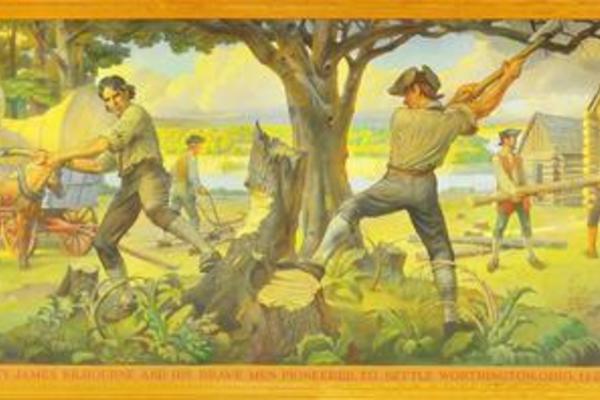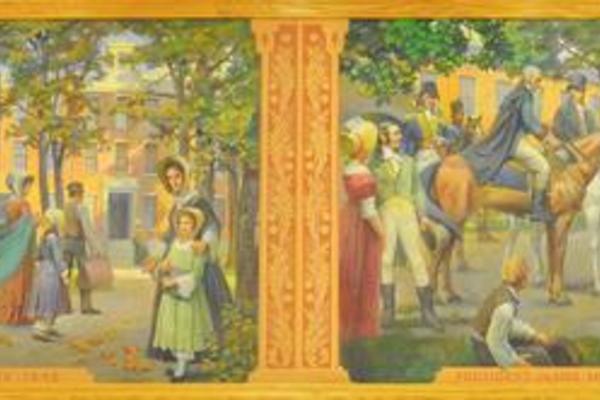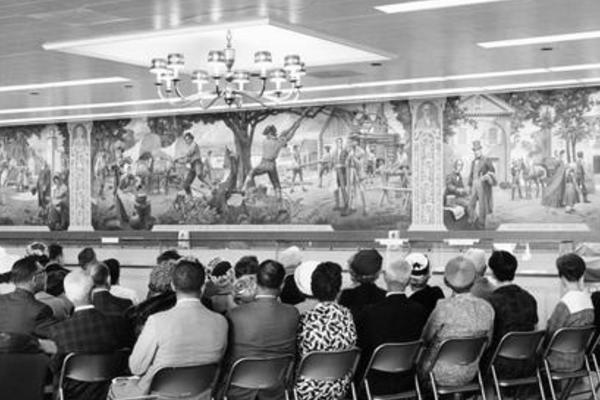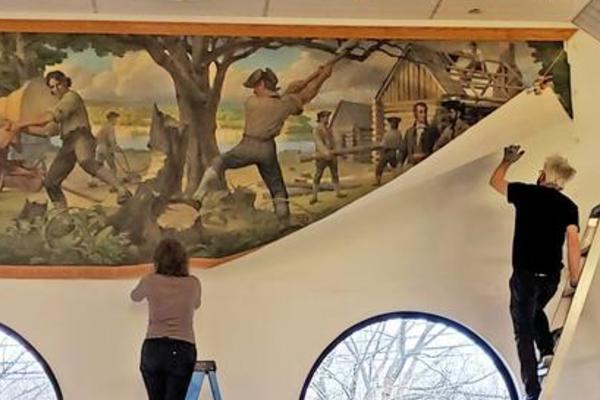Tuesday,
May 1, 2018
9:30am
Our May exhibit explores the history behind the murals that were displayed at Old Worthington Library for over 20 years.
When one of downtown Columbus' biggest banks wanted to open a Worthington branch, it aimed for a big impression. In 1963, City National Bank opened a 12,000 square foot banking center at the corner of Broadmeadows Boulevard and High Street, just south of Worthington's city limits. And unlike many of today's nondescript suburban bank branches, this substantial building intended to charm the locals. Its showpiece decoration, a huge, 40-foot-long mural, depicted important moments in early Worthington history.
Today, both the mural and the bank remain linked to Worthington. The history mural now fills two walls in the popular collections area of Old Worthington Library, 820 High Street. They were installed there in 1997 after the bank branch closed. [See the final paragraph of this exhibit for a 2021 update on the removal of the murals.] As for the bank, its roots can be traced all the way back to Francis Sessions-- the son-in-law of Worthington entrepreneur Orange Johnson-- who founded what, through mergers, would eventually become City National Bank and its parent, JPMorgan Chase & Co.
The mural consists of three panels. The largest, which was the central image when originally installed, imagines the 1803 arrival of James Kilbourne and a crew of eight men as they spent their first days preparing the land for the settlers who would arrive later that year. Today, this panel fills the east wall of the library's popular collections area on the main level.
Two smaller panels, which originally flanked the 1803 depiction, describe U.S. President James Monroe's 1817 visit to Worthington and an imaginary view of downtown Worthington in 1842. These two panels hang on the west wall of the popular collections area.
Louis P. Szanto and Andrew B. Karoly, two Hungarian artists from New York, painted the mural. During the 1950s and early '60s, they worked extensively in Cleveland, painting more than 30 murals for area businesses. Szanto and Karoly painted murals for at least a dozen bank branches for their biggest Cleveland client, the Society for Savings.
City National's murals present a romanticized picture of Worthington's past and appealed to "traditional values" at a time when Worthington was facing rapid change. Since the late 1950s, the city had been fighting off proposals to run a Columbus outerbelt just south of town and there was talk of turning the rural Olentangy River valley into a huge freeway. Development of 1,000 new home sites on 300 acres began in 1962 as farm fields were bulldozed for the Worthington Estates housing development. The Worthington Historical Society purchased the Orange Johnson House in 1963 as a restoration project but, a year later, preservation efforts would fail to prevent the demolition of the Griswold Tavern, a significant landmark on the Village Green.
In the early 1960s, Worthington, like most of the country, was infatuated with all things colonial. It would be difficult today to mistake the City National Bank for a building constructed in the American colonies before the American Revolution. By 1963, colonial style had come to represent a pleasant mishmash of traditional architectural features from the 18th and early 19th centuries.
And the bank certainly played up its "traditional colonial" style. The huge murals were a big attraction. At the grand opening event in March 1963, 2,500 people attended (nearly 30 percent of Worthington's entire population). The event was billed as "Old Fashioned Friendliness in a modern day bank." Hostesses greeted guests in vaguely antebellum gowns; attendees received a commemorative gift of "specially prepared home made bread and old fashioned apple butter." The "Worthington News" was enthusiastic: "The office, newest of City National's locations and of Colonial Architecture, is designed to fit in with the historical tradition of the Worthington Area. Everything possible has been done to make the new office an integral part of the Worthington Area. From the colonial cupola to the Colonial interior furnishings of the banking lobby, the office complements the fine tradition of the Worthington Area."
The bank had a strong tie to Worthington, even beyond its colonial affinity. In 1847, Mary, the only surviving child of Worthington entrepreneur Orange Johnson, married Columbus businessman Francis Sessions. In 1869, Sessions founded Commercial National Bank at High and Long streets in Columbus. At the time of his death in 1892, the bank he launched had grown to one of the largest in the city. By the 1920s, Commercial National Bank had become City National Bank through a series of mergers. In 1979, City National was renamed Bank One of Columbus and, in 2004, it merged with JPMorgan Chase & Co. Today, Chase employs 18,700 people at its campus just north of Worthington.
Bank One of Columbus closed the Broadmeadows branch in 1996, but donated the murals to the Worthington Historical Society. Installed in Old Worthington Library the next year, the murals remain a prominent reminder of Worthington's long history.
In a 2021 update to this exhibit, the murals were removed from the library in late 2020 and returned to the historical society. In the years prior to that, a growing number of library patrons had voiced their discomfort with the mural being prominently displayed in a public library, as it depicts not only a romanticized view of colonial America, but also celebrates a time period when Native Americans were being forcibly removed from their land and Black people were held in slavery. As part of the library’s Anti-Racist Resolution, passed in September 2020 after a summer of increased understanding and awareness of issues related to racial justice and systemic racism, it was decided that the mural would be returned and that space would feature art highlighting the library’s role as a community center for all.




